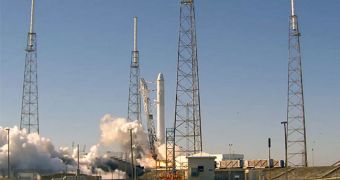Officials with the Space Exploration Technologies Corporation (SpaceX) announce that they were successful on Saturday, December 4, in conducting a planned static test fire of their second Falcon 9 rocket.
The test was critical for allowing the medium-lift delivery system to take the Dragon unmanned space capsule to low-Earth orbit (LEO). It was originally scheduled to take place on Friday, but a glitch in one of the engines caused a stall.
It would now appear that Merlin engine number 6 was the root cause of the problem. Incorrect configuration of its parameters led to it experiencing too much pressure, which forced the company to abort the test at T -1 seconds.
On Saturday, the issues had been fixed, and SpaceX experts gave the order to begin the test at precisely 10:50 am (1550 GMT). The assessment itself lasted for about 2 seconds, which was more than enough for engineers to collect all the data they needed.
“We will continue to review data, but today's static fire appears to be a success,” officials at the company said in a statement. This means that the path to Tuesday's launch is now open.
The Falcon 9 delivery system will fly to space carrying the Dragon capsule, which is the main objective of the current flight. The June 2010 Falcon 9 flight was meant to assess the rocket's performance, whereas the current one is aimed at the cargo ship itself.
After take-off, the capsule needs to be able to separate from its payload fairing, complete at least 4 orbits around the planet, demonstrate that it responds well to commands, and test communications and telemetry equipment.
After all this is done, the Dragon will need to reenter the Earth's atmosphere, which would represent a first time when a private company can, and has gotten a license to, do this.
The capsule will then crash-land in the ocean, where it will await retrieval by rescue teams. If the mission is a success, then SpaceX will start a contract calling it to make at least 12 resupply flights to the International Space Station (ISS).
The company is working under a $1.6 billion Commercial Orbital Transportation (COTS) program contract with the American space agency, which is funding the new demonstration flights.
As the shuttles are being retired, NASA wants to help the private sector develop spacecraft that would take over at least some of the orbiters' functions. SpaceX and Orbital Sciences Corporation are just two of the companies thus far tapped to help, Space reports.

 14 DAY TRIAL //
14 DAY TRIAL //